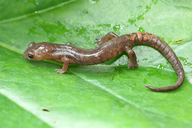|
Bolitoglossa conanti McCranie & Wilson, 1993
Conant's Mushroomtongue Salamander Subgenus: Magnadigita | family: Plethodontidae subfamily: Hemidactyliinae genus: Bolitoglossa |
 © 2007 Sean Michael Rovito (1 of 9) |
|
|
|
Description Bolitoglossa conanti can be distinguished from its close relatives within the B. dunni group by its dorsal coloration patterns and toe webbing. Other members of the B. dunni group are mahogany red over the whole body while B. conanti is sepia with either a reddish-brown strip stretching form the snout onto the tail or gold spotting. Additionally, the subcaudal region of B. conanti is tan to dark brown and the top of the feet in B. conanti lacks any conspicuous gold spots. Bolitoglossa conanti also differs from other species by teeth, webbing of the hands and feet, head width, and relative total length. More specifically, B. conanti differs from B. cuchumatana by the former having a broad stripe and/or speckling (see above), and toe webbing that leaves 1.5 - 2 phalanges between toes 3 and 4 free while the latter has pale dorsolateral stripes on dorsum, a background color of pale orange-yellow with gray mottling on the subcaudal region, and toe webbing that frees 0.5 - 1 phalanges between toes 3 and 4. Bolitoglossa conanti differs from B. engelharti by the latter having a uniform dorsal coloration with no patterning, smaller total length averaging 39.9 mm, more maxillary teeth (49.5 in the latter species and 47 in B. conanti), and one phalange of the longest toe free of webbing. Bolitoglossa conanti differs from B. helmrichi by the latter having an orange subcaudal region and having only the distal tip free of the longest toe free of webbing. Bolitoglossa conanti differs from B. rostrata by the latter having pale dorsolateral stripes or a uniform dorsum, a uniform subcaudal region ranging in color from pale beige to dull yellow, having a larger total length (average of 53.2 mm in males and 59.3 in females), and having more than 2 phalanges free of webbing (McCranie et al. 1993). In life, coloration is variable from sepia to amber. The species has two main color phases but may also exhibit intermediate patterning. One phase is a pale, orange-rufous to brown longitudinal band from snout tip to the dorsal tail surface. The other has dark brown dorsal surfaces with gold spotting or blotching. The subcaudal surface is spotted with gold and sometimes silver on a tan to dark brown background. Irises are also variable ranging from rufous brown to gold with brown or black patterning. Two preserved specimens had dark brown dorsal surfaces with lighter brown spots. (McCranie et al. 1993). Coloration patterns vary between the two described phases with intermediate stages. The maxillary and vomerine tooth number is also somewhat variable. Females are more robust than males, lack mental glands, have premaxillary teeth behind the lip (rather than piercing), and have eyes that are not visible from the ventral view (McCranie et al. 1993). Distribution and Habitat Country distribution from AmphibiaWeb's database: Guatemala, Honduras
Life History, Abundance, Activity, and Special Behaviors As of February 2016, the Toledo Zoo has a captive breeding program for this species and has had at least one successful hatching. The species appears to be fossorial and burrows deep during the dry season, which may be required for breeding. The females excavate a subterranean cavity, swells with water to maintain hydration in eggs, and remains with offspring a few weeks after hatching (Tim Herman, personal communication). Trends and Threats Currently, B. conanti is protected in Honduras, in areas such as Parque Nacional Cerro Cusuco, Parque Nacional Cerro Azul, and a watershed reserve at Río Santa Ana (Cruz et al. 2010). Possible reasons for amphibian decline General habitat alteration and loss Comments The species is named in honor of Roger Conant, for his contributions to the field of herpetology (McCranie et al. 1993). Bolitoglossa conanti is a member of the Bolitoglossa dunni group (McCranie et al. 1993). It is also included in subgenus Magnadigita (Frost 2011; Wiens et al. 2007). Bolitoglossa conanti is associated with Tillandsia sp. arboreal bormeliads and occurs sympatrically with B. dunni, B. rufescens, and Cryptotriton nasalis (McCraine et al. 1993).
References
Cruz, G., Wilson, L.D., McCranie, R., Castañeda, F., Vásquez, C., Rovito, S., Kolby, J. (2010). "Bolitoglossa conanti." In: IUCN 2011. 2011 IUCN Red List of Threatened Species. http://www.iucnredlist.org/. Downloaded on 21 Mar 2012. Frost, D. (2011). Amphibian Species of the World: an Online Reference. Version 5.5. McCranie, J. R., and Wilson, L. D. (1993). ''A review of the Bolitoglossa dunni group (Amphibia: Caudata) from Honduras with the description of three new species.'' Herpetologica, 49, 1-15. Stuart, S., Hoffmann, M., Chanson, J., Cox, N., Berridge, R., Ramani, P., Young, B. (eds) (2008). Threatened Amphibians of the World. Lynx Edicions, IUCN, and Conservation International, Barcelona, Spain; Gland, Switzerland; and Arlington, Virginia, USA. Wiens, J. J., Parra-Olea, G., García-Paris, M., and Wake, D. B. (2007). ''Phylogenetic history underlies elevational biodiversity patterns in tropical salamanders.'' Proceedings of the Royal Society B, 274, 919-928. Originally submitted by: Adriana Blair, Lucas Hammons, and Justin Haasis (first posted 2011-04-20) Edited by: Mingna (Vicky) Zhuang, Ann T. Chang (2016-03-17) Species Account Citation: AmphibiaWeb 2016 Bolitoglossa conanti: Conant's Mushroomtongue Salamander <https://amphibiaweb.org/species/3964> University of California, Berkeley, CA, USA. Accessed Nov 26, 2024.
Feedback or comments about this page.
Citation: AmphibiaWeb. 2024. <https://amphibiaweb.org> University of California, Berkeley, CA, USA. Accessed 26 Nov 2024. AmphibiaWeb's policy on data use. |




 Raffaëlli Account
Raffaëlli Account Map of Life
Map of Life